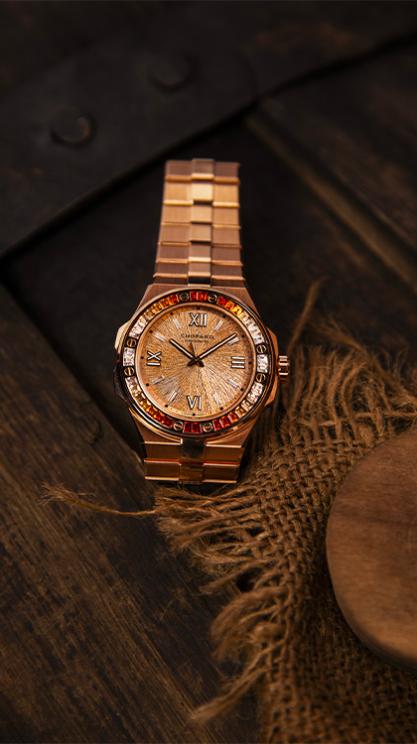The clouds are low and threatening on this rainy February day. According to the locals, it’s typical weather for the time of year. The winters are long around here, and the fog tends to linger, but there’s no point complaining. The austere winters also have their charm. The endless vista of rolling hills and fields criss-crossed by dry stone walls is draped in a delicate veil of mist. A group of buildings dating back to the 19th century stand along the banks of Pitilie Burn near the village of Aberfeldy in the foothills of the Highlands. Here, in the bucolic setting of the distillery founded by the Dewar family in 1898, we meet photographer Andy Barnham for our Chopard photo shoot, which will feature three watches: an Alpine Eagle Summit, an L.U.C XPS and a delicate Happy Sport.
Why did we choose a whisky distillery as the backdrop for these three models? Originally, it was the Alpine Eagle Summit with its warm colour palette reminiscent of whisky that inspired the location. Its 41 mm case made from ethically sourced rose gold offers a tone-on-tone juxtaposition with the dial, whose textured surface winks like an eagle’s eye. The gems set around the bezel, an elegant gradient of spessartites and white sapphires in a palette of ochre and brown, orange and beige, bring to mind the velvety golden lustre of a 15-year-old single malt. But appearances aren’t everything. Chopard’s watchmaking has a great deal in common with the art of distillation, as practised by the family firm founded by John Dewar. Here are the main three.

1. A family affair
Family. This is probably the most important feature of both the Chopard manufacture and the Aberfeldy distillery. A guided tour of the premises always begins with a visit of the small museum decorated in authentic Victorian style. Beginning in 1848 Dewar worked as a wine and spirits merchant in Perth, before he began combining different whiskies to produce his own blends. He was joined by his two sons, John Alexander and Tommy, who helped to grow the business. Today, the firm has joined the Bacardi stable.
That’s where the parallel ends, as Chopard remains fiercely independent. The family Maison was founded in 1860 by Louis-Ulysse Chopard. A century later, in 1963, the brand was bought by the Scheufele family, who have helped it grow from strength to strength. Co-presidents and siblings Karl-Friedrich and Caroline Scheufele, each with their own area of expertise, together define the brand’s strategy and artistic direction. Three generations of the family joined to create the sport-chic Alpine Eagle, Chopard’s latest collection: grandson Karl-Fritz, Karl-Friedrich the father, and Karl the grandfather.

Caroline Scheufele brings her creativity to Chopard’s collections. This is the latest Happy Sport to join the eponymous collection created by Caroline in 1993. Three decades ago she tapped into the zeitgeist, developing a watch that was both sporty and elegant, based around the innovative combination of mobile diamonds and steel. The recipe was extraordinarily successful at the time, and continues to turn heads today. Every year brings new versions, and new ways of celebrating the spirit of joie de vivre. This year’s 30 mm version in rose gold features a delicate peppermint green mother-of-pearl dial.

2. Savoir-faire, an essential ingredient of success
Savoir-faire, an appreciation of tradition, celebration of heritage: these core values are shared by both Chopard and the Aberfeldy distillery. There are precisely three ingredients that go into a single malt: barley, yeast and water. The production process is a little more complex, however. Malting, grist, mashing, distillation and ageing in oak barrels are the steps followed by every whisky producer in Scotland. But every one of them has a different recipe, and that’s what gives the whisky its special character, its distinctive aromas.
In the first step, the malting process, barley grains are germinated and then dried, sometimes with the aid of a peat fire.

The barley is then ground up to produce the grist, which is transferred to a tank and mixed with water to produce a thick, sweet liquid, and the initial fermentation takes place. The ferment is then transferred to large copper alembics, which produce a crystal-clear liquid with a very high alcohol content of around 70%. Water is added to bring the alcohol level down to 63.5%, and the oak casks – and time – do the rest. This is where the whisky gradually develops its warm amber hue and its complex aromas. Old bourbon barrels impart a honeyed sweetness to the whisky, while Spanish sherry casks add a more floral bouquet. The flavours become more pronounced the longer the whisky is aged.
The ingredients may be the same but there are countless different ways to make it. And this is another similarity with watchmaking. From design to movement construction, different watch brands can produce objects that are worlds apart. From a purely aesthetic point of view, looking for parallels between a Patek Philippe and a Roger Dubuis would seem a fruitless exercise for anyone interested in watchmaking. The same applies to the production process, which often varies from one manufacture to another.

Chopard has chosen to bring as much as possible of its manufacturing in-house. Complications, ultra-thin movements, decoration – the brand is committed to preserving the traditional techniques passed down by generations of craftsmen, and nurtures its in-house expertise. Chopard even has its own gold foundry. Its Fleurier workshop combines traditional techniques with avant-garde processes to develop and produce movements that are recognised for their reliability, robustness and precision. The movement inside the L.U.C XPS in platinum is a prime example. This COSC-certified ultra-thin calibre measuring just 3.30 mm is traditionally decorated with Geneva striping. All L.U.C movements produced by Chopard in Fleurier are hand-finished.
3. An international reputation
From Switzerland to Scotland, from watchmaking to whisky, both Chopard and the Aberfeldy distillery are extremely successful at what they do. Chopard’s spirit of innovation, commitment to ethical practices, and pursuit of excellence have earned it a worldwide reputation for its watches and jewellery. Aberfeldy and Dewar’s are part of the Bacardi portfolio of exceptional whiskies. Their traditional distillation methods are appreciated by connoisseurs all over the globe. Their exemplary history has taken them from a small family firm to a global group with an international reputation.







